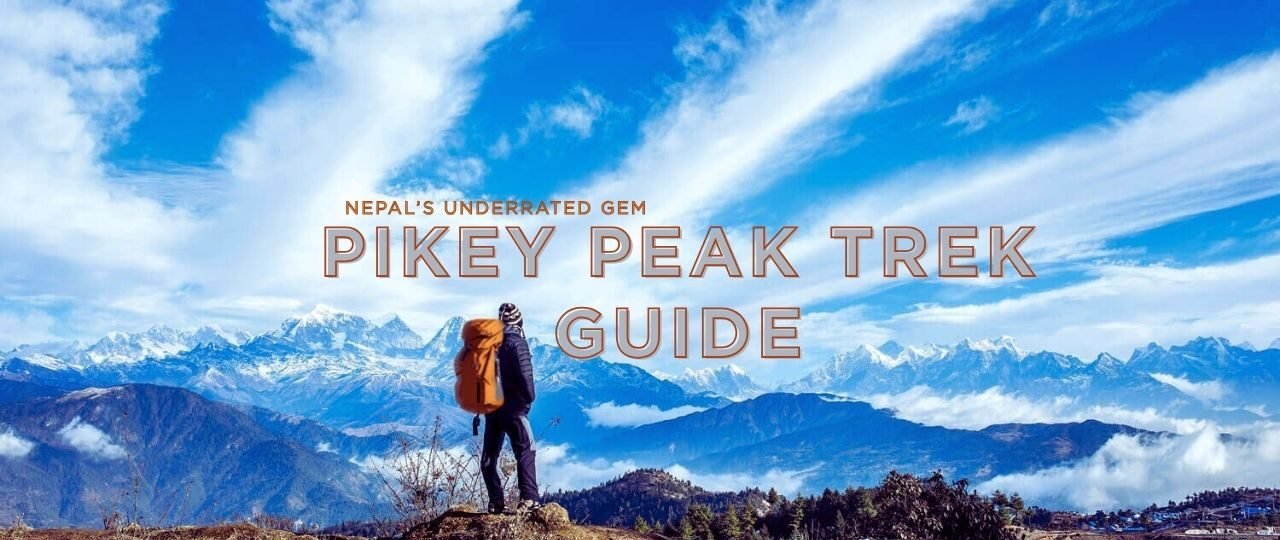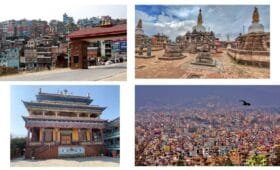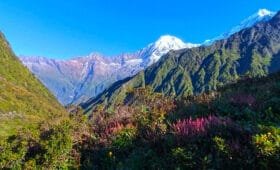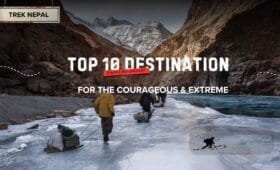The Pikey Peak Trek has swiftly gained attention among adventurers seeking an unspoiled yet accessible Himalayan route. Situated in the lower Solu region, the Pikey Peak Trek unveils a panoramic feast of Mt. Everest, Makalu, Kanchenjunga, and even distant Annapurna summits on clear days. For many, the trek’s vantage from Pikey Peak—sitting at an approximate elevation of 4,065 meters—delivers one of the best sunrise panoramas in Nepal. Simultaneously, the route meanders through the cultural enclaves of Rai and Sherpa communities, guaranteeing a memorable blend of scenic grandeur and local authenticity.
In this comprehensive Pikey Peak Trek Guide article, we’ll dissect every aspect of the Pikey Peak Trek. We will detail the recommended Pikey Peak Trek Itinerary, evaluate the Pikey Peak Trek Cost, highlight the difficulty and best times, and even share philanthropic options through Volunteers Initiative Nepal (ViN). If you’re craving a moderate trek with jaw-dropping panoramas, the Pikey Peak Trek proves itself a hidden jewel that merges challenge, culture, and philanthropic potential in one incredible journey.
Introduction
1. Introduction: Why the Pikey Peak Trek?
While significant names like Everest Base Camp overshadow many lesser-known routes, the Pikey Peak Trek offers a scenic alternative often described by locals as the vantage for “the best view of Everest.” The trek’s moderate difficulty suits both novices and intermediate hikers seeking quiet trails, historic monasteries, and the chance to observe authentic village life. Reputedly, Sir Edmund Hillary himself once proclaimed the Pikey region boasted his favorite Everest view.
Statistic: According to local tourism boards in Solukhumbu District, fewer than 5,000 foreigners attempt the Pikey Peak Trek annually, a fraction of those heading to EBC. This low footfall fosters an unspoiled environment where teahouses remain cozy, and villagers greet visitors with genuine hospitality.
“I had never heard of Pikey Peak until a friend recommended it, but it turned out to be a highlight of my Nepal trip—serene trails, warm local tea houses, and an unbeatable sunrise over Everest,”
says Martina, a 27-year-old trekker from Germany.
Overview
2. Cultural & Geographical Overview
2.1 Sherpa & Rai Influences
Although the higher Khumbu region is often overshadowed, lower Solu is equally steeped in Himalayan culture. Sherpas, along with the Rai people, inhabit many areas known for vibrant festivals, local brews, and a unique language. Trekkers may visit local gompas (monasteries), spinning prayer wheels or crossing chortens, symbolizing Buddhism’s presence. Meanwhile, farmland terraces reflect rural lifestyles anchored in agriculture and yak or cattle rearing.
2.2 Pikey Peak Landscape
Pikey Peak (roughly Pikey Peak Trek Elevation ~4,065m) soars above rolling hills, pine forests, rhododendron groves, and open ridgelines. The vantage captures a wide swath of eastern Himalayan peaks, including Everest, Makalu, Kanchenjunga—and sometimes Dhaulagiri or Annapurna if the sky is clear. Combined with lower-altitude flora and fauna, the environment transforms daily, from sub-tropical farmland to alpine meadows near the top.
Trek Itinerary
3. Pikey Peak Trek Itinerary
While variations abound, a typical Pikey Peak Trek Itinerary from Kathmandu might span 7–9 days. Below is a representative 8-day schedule:
Day 1: Drive Kathmandu → Dhap (~2,940m), Trek to Sigane (~2,200m)
~6-hour jeep/bus to Dhap. A short ~2–3 hour hike downhill or moderate terrain to Sigane for the first overnight.
Day 2: Sigane → Jhapre (~2,820m)
~5–6 hours. Pine forests, terraced farmland, and occasional glimpses of Numbur Himal. Teahouse lodging at Jhapre.
Day 3: Jhapre → Pikey Base Camp (~3,640m)
~5–6 hours. The trail passes yak pastures, culminating near the base camp area. The scenic vantage of Gauri Shankar, Dhaulagiri, if the weather cooperates.
Day 4: Summit Pikey Peak (~4,065m), Trek to Loading (~2,500m)
Early morning 1–2 hour ascend to Pikey Peak for sunrise. Marvel at an unblemished panorama of Everest, Makalu, Kanchenjunga, and maybe Annapurna. Then ~5–6 hour descent to Loding.
Day 5: Loding → Junbesi (~2,700m)
~5 hours. Gentle ridges, passing local villages. Junbesi is a Sherpa settlement with a notable monastery.
Day 6: Junbesi → Thupten Chholing Monastery → Junbesi
Optional ~3–4 hour round trip exploring Thupten Chholing, a significant monastic community. Return to Junbesi or push onward.
Day 7: Junbesi → Phaplu (~2,413m)
~5 hours. This final trek day weaves through farmland. Phaplu hosts a small airstrip and road connections.
Day 8: Drive or Fly Phaplu → Kathmandu
Either ~7–8 hour jeep or ~30-min flight if available.
Pikey Peak Trek Duration typically 7–9 days total, not including buffer days in Kathmandu. Some travelers compress or extend the route with side expansions to Taksindu or link with other Solu trails.
Distance
4. The Pikey Peak Trek Distance
Pikey Peak Trek Distance is ~60–70 km across 7–9 trekking days. Daily segments vary ~8–15 km, typically 5–7 hours of walking. The route’s maximum altitude is ~4,065m at Pikey Peak itself. Although not as long or high as major Himalayan treks, the route’s undulating terrain can still challenge novices. Many appreciate the moderate scale, combining scenic ridgelines without Everest or Annapurna circuits’ extreme altitudes or crowds.
Trek Difficulty
5. Evaluating Pikey Peak Trek Difficulty
Pikey Peak Trek Difficulty is moderate:
- Altitude: At ~4,065m, altitude sickness risk is present but lower than 5,000m+ circuits. Acclimatization typically occurs naturally due to the route’s steady progression.
- Trail Conditions: The path includes forested ridges, farmland, and rugged slopes near the peak. There are some steep ascents/descents daily.
- Daily Duration: ~5–7 hours of trekking. It is manageable for novices with moderate fitness.
- Lodging & Infrastructure: Teahouses exist but are more straightforward than commercial routes. Basic amenities require flexibility.
In summary, while not a walk in the park, the Pikey Peak Trek suits those comfortable with moderate climbs. It’s less physically intense than advanced passes or extended ABC/EBC treks, but appropriate preparation (cardio, gear, etc.) remains vital.
Trek Cost
6. Budget Matters: Pikey Peak Trek Cost
Pikey Peak Trek Cost is relatively affordable, reflecting minimal flights or restricted permits. Key cost elements:
Transport
Bus/jeep from Kathmandu to Dhap or Phaplu: ~USD 10–15 for a public bus, ~USD 20–30 for a local jeep seat, or ~USD 150–200 for a private jeep if shared among a group.
Accommodation & Food
Teahouse rooms: ~USD 3–6 per night. Meals ~USD 5–10 each. Daily meal budget ~USD 20–25.
Permits
Pikey Peak Trek Permits: Typically, Gaurishankar Conservation Area Permit (~USD 20–30) or local municipality fees. Confirm updates.
TIMS card (~USD 10–20).
Guide & Porters
A Pikey Peak Trek Guide is optional (~USD 25–30/day). A porter runs ~USD 15–20/day.
Misc
Hot showers (~USD 2–4), device charging (~USD 1–2), and occasional Wi-Fi fees (~USD 2–3).
Hence, a 7–9 day trek might cost ~USD 300–500 if teahouse style, plus possible transport expansions. Agencies offering Pikey Peak Trek Package could charge ~USD 500–800, covering lodging, partial meals, and staff wages.
7. Mandatory Pikey Peak Trek Permits & Local Fees
Though overshadowed by Everest or Annapurna regulations, the region sits partially within Gaurishankar Conservation Area or near Sagarmatha zones. Confirm local guidelines:
- Gaurishankar Conservation Area Permit: ~USD 20–30.
- TIMS Card: ~USD 10–20.
- Some areas have local municipality fees. Check with an official or your guide.
No restricted-area permit is required for standard routes around Pikey Peak. However, it’s best to verify with a Pikey Peak Trek Guide or local tourism board, as policies can change. Keep passport copies as you might face occasional checkpoints or local tax.
Best Time
8. The Right Season: Pikey Peak Trek Best Time
Pikey Peak Trek Weather typically follows Himalayan mid-hill patterns:
Autumn (Sept–Nov)
Crisp skies, mild days (~15–20°C below 3,000m), and sub-zero nights near Pikey Peak. Minimal rainfall, best mountain clarity.
Spring (Mar-May)
Rhododendrons bloom in forest belts, moderate daytime temps, and possible mild precipitation. Generally clear morning views.
Winter (Dec–Feb)
There are fewer tourists and sub-zero nights near 4,000m. The route is open, but prepare for cold—crisp days with fewer clouds are possible.
Monsoon (Jun–Aug)
Lush farmland, frequent rain, cloud cover obscuring peaks, leeches in wooded areas, and possible road disruption.
Hence, the Pikey Peak Trek Best Time is autumn or spring for stable conditions and scenic mountain vistas. Winter suits those tolerating cold nights in simpler teahouses, while monsoon is the least ideal for photography or easy travel.
Accommodation
9. Accommodations & Food: Pikey Peak Trek Accommodation
Pikey Peak Trek Accommodation largely relies on basic teahouses:
- Dhap & Sigane: Simple lodges or homestays, shared rooms, limited menus.
- Jhapre: A few teahouses, hearty local meals (dal bhat, noodles, Tibetan bread).
- Pikey Base Camp: Fundamental lodging, possibly communal rooms or limited capacity, especially in the off-season.
- Junbesi: Larger settlement with more teahouses, some with comfortable private rooms.
Expect standard Nepali fare—dal bhat, noodles, momos, chapati. Western items like pasta or pizza appear but cost more. Winter or monsoon might see fewer teahouses open, so confirm availability with your Pikey Peak Trek Guide.
Weather
10. Handling Weather & Altitude: Pikey Peak Trek Weather & More
Pikey Peak Trek Altitude hovers from ~2,000m near Dhap or Sigane to ~4,065m at the summit. This lesser altitude reduces acute AMS risk, though some individuals still experience mild breathlessness near Pikey Peak. Drink ample water, ascend gradually, and watch for dizziness or headaches.
Pikey Peak Trek Weather near the top can be unpredictable. Autumn yields bright skies with night temps near freezing. Spring sees comfortable days but the possibility of storms. Winter’s dryness can yield crystal views but sub-zero nights. The region rarely encounters the extremes of 5,000–6,000m routes, making Pikey suitable for novices or shorter holiday windows.
FAQs
11. The Seven Most Frequently Asked Questions
What is the Pikey Peak Trek Distance?
Typically ~60–70 km total over 7–9 days, averaging 8–15 km daily.
How difficult is the Pikey Peak Trek Difficulty?
Moderate. The highest point at ~4,065m is daily walks ~5–7 hours. Great for novices with decent fitness.
How much does the Pikey Peak Trek Cost?
~USD 300–500 for an independent teahouse trek. A Pikey Peak Trek Package might be ~USD 500–800 with partial coverage of lodging, meals, and a guide.
Which permits are needed for the Pikey Peak region?
Usually Gaurishankar Conservation Area Permit (~USD 20–30) + TIMS (~USD 10–20). Check with local agencies or your guide for updates.
When is the Pikey Peak Trek Best Time?
Autumn (Sept–Nov) or spring (March). Winter suits those braving cold nights, while monsoons see heavier rain and clouds.
Do I need a Pikey Peak Trek Guide?
Optional. The route is straightforward, but a guide (~USD 25–30/day) offers local insights, ensures teahouse bookings, and enhances cultural experiences.
What is the maximum Pikey Peak Trek Elevation?
~4,065m at Pikey Peak summit, where sunrise views may reveal Everest, Makalu, Kanchenjunga, plus others on a clear day.
Trek Tips
12. Additional Pikey Peak Trek Tips & Packing Advice
Pikey Peak Trek Packing List might include the following:
- Clothing
- Thermal base layers, fleece or down jacket, waterproof shell.
- Proper trekking pants, gloves, beanie, sun hat.
- Footwear
- Broken-in hiking boots, trekking socks, and optional gaiters for muddy or snowy segments.
- Gear
- Trekking poles, daypack (~25–35L), water purification tablets, personal first-aid kit.
- Extras
- Sunglasses, sunscreen (SPF 30+), lip balm, quick-dry towel.
- Snacks (protein bars, nuts), re-sealable bag for trash.
- Documents
- Permits, TIMS, passport copies, travel insurance covering up to ~4,500m.
Pikey Peak Trek Tips:
- Cultural Etiquette: Ask before photographing locals. Greet with “Namaste. “ Remove shoes in monasteries. Respect local norms.
- Acclimatize: Although the route is below 5,000m, slow ascents around the base camp area are recommended.
- Timing: Aim for an early morning summit push for sunrise. Crisp, less windy conditions offer the best vantage.
Reviews
13. Personal Stories & Pikey Peak Trek Reviews
Daniel’s Reflection
Daniel, a 35-year-old American traveler, found the Pikey Peak Trek “eye-opening,” describing a tranquil trek with minimal crowds, friendly villagers, and incredible glimpses of Everest at dawn. He notes that day four—when summiting Pikey—was the journey’s highlight, thanks to a panoramic vantage that dwarfed any prior experience.
Local Impact
Teahouse owners near Jhapre and Pikey Base Camp remark that tourism fosters local income, encouraging them to maintain well-kept lodges. Many Pikey Peak Trek Reviews praise the route’s authenticity—few big groups, more local interactions, stable prices, and a sense of discovering an untrammeled gem in the Himalayas.
Conclusion
From farmland-laced ridges near Dhap to the exhilarating vantage at ~4,065m, the Pikey Peak Trek merges moderate altitudes, short daily distances, and breathtaking Himalayan views. The route’s cultural tapestry—Sherpa villages, Tibetan-style monasteries, and scenic meadows—makes each day a fulfilling experience. Avoiding the crowds of more famous routes, Pikey Peak Trek stands as a perfect introduction to Nepal’s mountain wonders or a pleasant alternative for returning trekkers craving a new vantage.
charity trekking and travel tours
Double Impact with Volunteers Initiative Nepal (ViN)
Volunteers Initiative Nepal (ViN) organizes charity trekking and travel tours, channeling all proceeds toward community empowerment. By choosing the Pikey Peak Trek under ViN’s philanthropic framework, you create a “double impact”:
- Volunteer: Lend your education, health, or environmental expertise to local villages en route or near Solu-Khumbu.
- Intern: Link academic or professional research with real-world needs in remote communities.
- Donate: EveSl contributions accelerate school building, women’s empowerment, or health clinics.
- Share: Encourage friends, family, or social networks to adopt philanthropic trekking, forging a meaningful synergy of adventure and altruism.
Namaste—and may your footprints along the Pikey Peak Trek unify personal exploration with communal betterment, forging a future where tourism fosters positive transformations throughout Nepal’s mountainous heartlands.
Practical Guidance
Extended Practical Guidance & Final Inspiration
1. Seasonal Recap & Weather
- Autumn (Sept–Nov): Crisp days, ~15–20°C below 3,000m, sub-zero near Pikey. Clear mountain vistas.
- Spring (Mar-May): Blooming forests, comfortable days ~20°C at lower altitudes, possible afternoon showers.
- Winter (Dec–Feb): Fewer trekkers, sub-zero nights, and teahouses remain open but with minimal crowds—crisp morning views near Pikey Summit.
- Monsoon (Jun–Aug): Heavy rainfall, leeches, potential road closures, cloud-limited views. It is lush farmland, though.
2. Route Alternatives
- Thupten Chholing near Junbesi: Some extend the route to visit more enormous monasteries.
- Expansion: If time allows, connect with the Taksindu route or continue to remote parts of Solu.
- Shortcut: Some do a partial loop, starting from Phaplu or taking a bus from Kathmandu to Dhap, picking one direction to Pikey Peak summit, then returning.
3. Potential Challenges
- Altitude: Although max ~4,065m, caution is vital if you ascend quickly.
- Weather: Sudden storms can hamper vantage near the summit. Dress in layers and carry rain gear.
- Teahouse Capacity: Some teahouses near base camp fill up during peak autumn weekends or festivals. Arrive early or inform your guide.
4. Post-Trek Options
- Phaplu: If finishing near Phaplu, consider a scenic flight to Kathmandu or a ~7–8 hour jeep ride.
- Extension: Move to the classic Everest region trek if you have additional days.
- Volunteer: Engage in local projects post-trek or sign up for short stints with local schools or environmental efforts.
Final Summation
The Pikey Peak Trek stands as a hidden Himalayan gem for trekkers craving moderate difficulty, transcendent sunrise over Everest, minimal crowds, and cultural immersion in lower Solu. By partnering with Volunteers Initiative Nepal, your journey yields a double impact—fostering personal achievement and sowing seeds for sustainable community growth. So, lace up your boots: from farmland ridges to the summit’s panoramic vantage, the Pikey Peak Trek awaits, bridging your adventurous spirit with meaningful philanthropic engagement.




